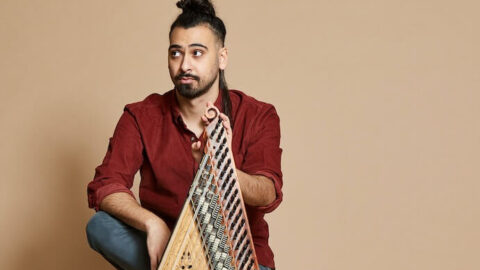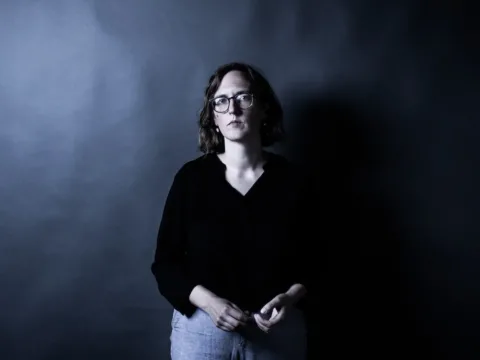Palestine-born Firas Zreik is a creator and collaborator based in New York City. He is an advocate for his instrument, the Kanun (a large zither played in much of Africa, the Eastern Mediterranean, and Central Asia), and the Arabic Maqam tradition (a system of modes and melodic idioms at the core of traditional Arabic music). And though both of these date back to at least the 13th century, Zreik has found rich new potential for them by embracing an expanded form of improvisation and novel ensembles that include Western musical instruments. His new album Salute, released March 8 on Levantine Music, combines Arabic Maqam and microtonal jazz with the Kanun at the center of an eight-piece band.
Watching your performances on YouTube, I was struck by your effortless ability to rapidly pluck melodies and bend pitches. What drew you to the Kanun, and how did you study it?
I think that getting drawn to an instrument, especially at an early age, is like love: it’s like having a crush, and it’s hard to describe or explain why you feel a certain attraction to that particular instrument. The Kanun has always intrigued me both sonically and aesthetically. Also, in Arabic, the word “Qanun/Kanun” translates to “The Law,” which gives it some sort of authoritarian nuance, and rightfully so, because the Kanun is the heart of the Arabic ensemble. It sets the tone and the tempo for the rest of the band, so I think that might have contributed to my overall fascination with it.
I studied with Mahran Moreb — my first and only Kanun teacher, for whom I have great respect and admiration. I studied with him at Beit Al Musica conservatory, in the Galilee (Northern Palestine, present-day Israel). There, I played in ensembles, recitals, studied Arabic music theory, Western music theory, and of course Kanun performance.
Beside studying with a teacher, I spent a lot of time listening to Kanun greats from the 20th century, transcribing their solos, and trying to imitate their techniques and phrasing, unaware that by doing so, I was actually shaping my own craftsmanship and vocabulary. I’ll mention Mohamed Abdo Saleh and Abraham Salman from Egypt and Iraq, respectively, as well as Goksel Baktagir and Aytac Dogan from Turkey, among many, many others.

The way audiences are enthralled by your virtuosic performances reminds me of the emotional transcendence associated with the Arabic concept of tarab. Do you agree? If so, how would you characterize your music’s spiritual ambition?
Absolutely. Tarab is the name of a genre, but it’s also a depiction of a state of mind. It refers to an ecstatic phase that the listener goes into as a natural reaction to what they’re hearing or feeling. The most fundamental relationship in live music is that of an audience-performer. While deep listening is an integral part of the experience, interacting is no less crucial. It opens up a cathartic expression platform, which, in return, fuels the performer with excitement and momentum. In my opinion, that elevates the quality of the show.
Feeling that energy from the audiences when they vocally express it is one of my favorite things on stage. Not only is it a rewarding feeling for both me and them, but it also tells me that they’re listening, engaging, and interacting at the right moments — that’s the magic of it.
I aspire for my music to evoke all kinds of emotions: mellowness, excitement, catharsis, tension, relief, sadness, happiness, longing, as well as movement and dance. I also aspire to have my music be accessible and enjoyable to different kinds of people and audiences from different backgrounds and tastes; if a barber in Egypt or a fisherman in Greece or a high-school teacher in France all enjoy my music, then I have succeeded.
Recently, I’ve been trying to understand the complexity of the Maqam tradition from my Western training perspective. It has an extraordinary number of modes, jins (scale fragments) within the modes, musical idioms, ornaments, and norms. As someone who studied jazz composition, what benefits of the Maqam form would you recommend to other jazz musicians?
Studying (and listening to) jazz has enlightened me tremendously. It opened my consciousness to new concepts, realms, sounds, and ideas that I would’ve missed otherwise, and that applies to other kinds of music that I frequently listen to, such as Baroque, flamenco, Brazilian, and Latin American music. So I believe that goes both ways: to anyone exploring Maqam repertoires from Egypt, Aleppo, Iraq, Turkey, Azerbaijan, or Persia, for the first time, it would be like discovering a hidden treasure; I say hidden because music from the East is not as promoted (or forced) to the masses as much as Western pop, jazz, and classical music, and that of course has its colonial and racial roots.
As for musicians in particular, listening to Maqam might enlighten them on concepts like microtonality, ornamentation, linear phrasing, and modal improvisation, but also just pure enjoyment. It is worth mentioning that the Maqam is the scale system and the vocabulary, but it is not a genre — there are various genres that deal with Maqamic idioms.
On your album, Salute, how did you incorporate piano with Maqam scales and your band’s other melodic instruments (Kanun, Nay, violin, bass)?
This is mostly a question of arranging and orchestrating; it requires absolute attention to detail that comes with deep understanding of scales, harmonies, microtones, and tendency notes, to make them all function together in a homogenous ecosystem. I think I succeeded in creating a palette that serves the melodies and complements them, rather than taming my melodies to fit into a traditional Western harmonic progression. I try to create something fresh and organic, but also intriguing.
At first, I had to explain the Maqam used in each tune to the musicians who weren’t familiar with the style, what chords work with what, what notes to avoid, and so on; but with time I feel that they have adapted beautifully to these concepts. Salute is the manifestation of my musical self, reflected in various elements, with the Maqam at the core.
Your work has been described as both preservationist and vanguard, regarding the Maqam. What do you consider essential to this type of music? What elements allow for experimentation, and does this change depending on who your audience is?
I’m not sure if my work is preservationist. But perhaps in a time where unique Indigenous cultures have been (and are still being) rapidly erased, reshaped, and replaced with monotonic sounds, shapes, and languages that fit the Anglo-Saxon taste — perhaps due to that notion, I sometimes seek preservative approaches as sort of a statement, or a survival mechanism.
But, overall, I like to think of myself as a contemporary creator, trying to enrich the repertoire and create something beautiful, original, and rebellious. In terms of experimentation, any element can be open for creativity: instrumentation, scales, rhythms, sounds, and concepts. It’s all about being constructive to the foundation; artistic rebellion is good, but it must come with added value. My constant challenge is to find that value.
I think that the mere idea of creating an instrumental project with the Kanun as the leader is already a tremendous leap for both myself and the instrument. The Arabic music repertoire is almost entirely vocal, and the main function of instrumentalists in that repertoire is to support the vocalist. The only times when instrumentalists shine in these contexts are during little moments of improvisation (which we call Taksim) and some instrumental transitions between verses.
Therefore, I believe it’s important to enrich the repertoire with instrumental works, to introduce the Kanun to new prospects, stretch the limits of the instrument, and utilize its full potential, which is yet to be realized. Additionally, having the Maqam as my main vocabulary, and seeing how it functions with other musical idioms without losing or compromising its authenticity, is definitely something I’m proud of, and I aspire to create more of.
I think different audiences can appreciate similar things; playing for an Arab audience is a thrill because they’re native to the sound and aesthetics. They naturally engage, but they’re also intrigued by all the other colors incorporated into that familiar sound. They might like it, or they might not, but it is still an interesting experience either way. Non-Arab or foreign audiences might not conceive of the performance as naturally, but they would still be even more intrigued by the instrument, first of all, as well as by the unfamiliar sounds. But from my experience, I’ve found that all audiences can appreciate a good sound — they can recognize talent, depth, and honesty, but most importantly, they feel something. To me, that’s the most profound thing, and it makes it a joy to perform anywhere.
I CARE IF YOU LISTEN is an editorially-independent program of the American Composers Forum, and is made possible thanks to generous donor and institutional support. Opinions expressed are solely those of the author and may not represent the views of ICIYL or ACF.
You can support the work of ICIYL with a tax-deductible gift to ACF. For more on ACF, visit the “At ACF” section or composersforum.org.
























